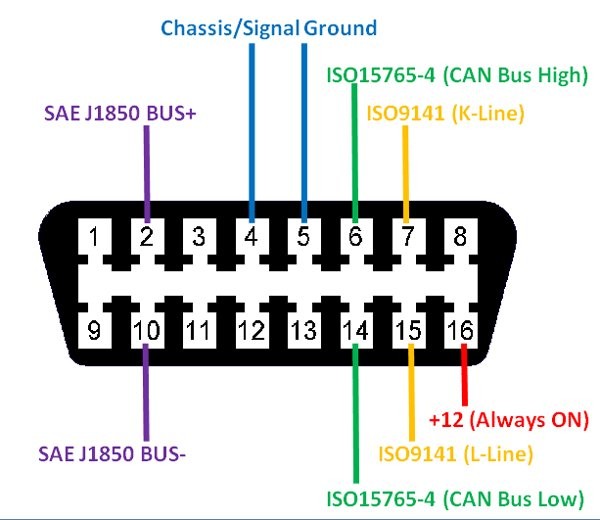Experiencing issues with your ABS light after installing an OBDII head-up display (HUD) speedometer? You’re not alone. Many car enthusiasts are drawn to the sleek integration of HUDs that project speed and other driving data directly onto the windshield, enhancing the driving experience. These devices conveniently plug into your car’s OBDII port, promising a seamless upgrade. However, some users, particularly those with older vehicles, have encountered a frustrating problem: the dreaded ABS light illuminating on the dashboard immediately after installation.
One such instance was reported by a user who installed an OBDII HUD in a 2001 Toyota Tundra. Much to their surprise, plugging in the speedometer instantly triggered the ABS warning light. Unplugging the device resolved the issue, pointing directly to the HUD as the culprit.
 OBD2 Connector Pinout Diagram for Automotive Diagnostics and HUD Installation
OBD2 Connector Pinout Diagram for Automotive Diagnostics and HUD Installation
Identifying and Resolving the Problematic Pin
The solution, as discovered through troubleshooting, often lies within the pins of the OBDII connector on the HUD itself. It’s been observed that in some cases, a specific pin on the HUD’s OBDII plug can cause interference with the vehicle’s systems, leading to the ABS light issue. In the Toyota Tundra case, pin 11 was identified as the source of the problem.
Before you start permanently modifying your HUD, it’s crucial to pinpoint the exact pin causing the conflict in your vehicle. Here’s a step-by-step method to safely isolate the problematic pin:
- Prepare for Testing: Gather a pair of needle-nose pliers. You will use these to carefully manipulate the pins on the OBDII connector of your HUD device.
- Pin Isolation Technique: Instead of immediately removing pins, the safest approach is to temporarily disable them. Start by gently bending pins 9, 10, and 11 downwards towards the connector housing using your needle-nose pliers. This will prevent these pins from making contact when plugged into your car’s OBDII port.
- Test After Each Pin Adjustment: After bending the first pin (start with pin 9, then 10, then 11 in separate tests), plug the HUD back into your car’s OBDII port and start the vehicle. Observe if the ABS light is still illuminated.
- Isolate the Faulty Pin: Repeat step 3 after bending each pin individually (9, then 10, then 11 in successive tests, returning the previous pins to their original position for each new test). If the ABS light disappears after bending a specific pin, you’ve identified the problematic pin. In the reported case, it was pin 11.
- Permanent Solution – Pin Removal (Once Identified): Once you’ve confidently identified the faulty pin (e.g., pin 11 in the example), you can proceed to permanently remove it from the HUD’s OBDII connector. Use your needle-nose pliers to carefully extract the pin from the connector housing. Important: Only remove the pin from the HUD’s connector, NOT from the OBDII port in your vehicle.
Understanding the Potential Cause
The underlying cause of this issue is often attributed to a potential short circuit or signal conflict caused by one of the pins in the HUD’s OBDII connector. By removing the interfering pin, you effectively eliminate the electrical conflict, allowing your HUD to function correctly without triggering the ABS light. It’s important to note that OBDII pin assignments can vary slightly depending on the vehicle and device, which is why testing each pin is crucial rather than blindly removing pin 11.
Despite this minor modification, the core functionality of your OBDII HUD speedometer should remain unaffected. You can continue to enjoy the benefits of having your speed and other vital information projected conveniently onto your windshield, enhancing your driving experience and allowing you to keep your focus on the road.
By following these steps, you can effectively troubleshoot and resolve ABS light issues caused by certain OBDII HUD speedometers, ensuring a smoother and safer integration of aftermarket technology into your vehicle. Remember to proceed with caution and test thoroughly before making permanent modifications. If you are uncomfortable performing these steps, consulting a qualified automotive technician is always recommended.
